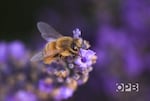Oregon is a great place to grow flowers. Our range of climates suits the cultivation of everything from English roses to desert sand lilies to skunk cabbage.
So, it might not be a surprise that Oregon is among the top U.S. producers of lavender. The fragrant purple flower adapts well to the state’s moderate temperatures, sandy, well-drained soils and dry summers.
The Oregon Lavender Association lists 45 member farms, and even provides a map for “lavender tourism,” with destinations in northern, central and southern Oregon. Many of the map’s destinations will guide you to luscious purple fields, saturated with a dizzying combination of floral perfume and bee hum. Now imagine all of that as the foreground to an unobstructed vista of Mount Hood and you have Lavender Valley Farm.
Located in Parkdale, the 28-acre growing operation cultivates 11 varieties of lavender and doubles as a day-trip destination between Memorial Day and Labor Day. For a nominal parking fee, visitors can snap selfies that appear to be set in a fairy tale and cut aromatic bundles to carry home. A small gift shop offers soaps, balms and even lavender honey, all produced on-site.
This piece of paradise is where Francisco Ojeda spends his summers managing farm operations from growing, to harvesting and pruning, to production, bottling and marketing. His small team includes Geronimo Hurtado, an expert horticulturist in the area.

Geronimo Hurtado has mastered the tricky task of pruning and harvesting lavender in one fell swoop
Stephani Gordon
“Geronimo is very adept at, we call it, giving it the haircut, (because) not only is he harvesting, but he’s actually pruning at the same time,” says Ojeda. If these twin tasks aren’t done correctly, it can have dire consequences for the plant.
“It’s really important when you’re pruning a lavender plant to leave a little bit of the new growth,” Ojeda says. “Unlike many other shrubs where you can kind of cut them back hard, lavender isn’t as forgiving. He’s really mastered the art of pruning it and shaping it.”
Once harvested, a steam distillation process releases and carries oil molecules from the flower buds, then separates the essential oil from a lavender distillate known as hydrosol, as it cools. Ojeda calls the hydrosol a “miracle” product that can be bottled as linen spray, skin toner, and window cleaner.
“We’ve got some of the farmers coming in, buying it in big quantities (to) wash their horses down because it’s a natural mosquito and insect repellant,” he says.

Honey produced by these bees has a distinct lavender aroma and subtle taste
Stephani Gordon
As versatile as the hydrosol is, the real treasure is the oil. Lavender’s essential oils have a storied history going back at least 2,500 years. Legend has it that Cleopatra seduced Mark Antony with the fragrance, and many health practitioners swear by the scent’s calming effect.
One variety that was developed on the farm is called “Mellissa,” named for the wife of the former grower.
“We’re fortunate enough here in Hood River (Valley) to be able to grow it. And it has a very light pink to purple-ish flower so it’s really beautiful, but also produces some of the most floral fragrance. It’s almost like a perfume quality,” says Ojeda.
That perfume-like profile comes at a price in the volume of essential oils collected.
“Unlike some of the other varieties that produce (about) two gallons,” Ojeda notes. “Seventy-five plants would give us about a half a gallon. But what it gives us is just pure gold.”
The COVID-19 pandemic made 2020 a challenging year to be in almost any kind of business. Lavender Valley also experienced that uncertainty.
“In February and March, we were really unsure if we were going to be able to open. Thankfully for us, our season starts in May. So it did afford us a little more time than some of the other businesses that opened earlier,” remembers Ojeda.

Visitors to Lavender Valley Farm in Parkdale snap an idyllic picture
Stephani Gordon
“We’re very fortunate that we’ve got 28 acres here. So it’s been easy to maintain social distancing. And so it’s an opportunity for families and people to get out of their homes, many of them for the first time in a long time.”
Those who did make the trip were rewarded with an outdoor experience that seems to have also delivered a much-needed sense of well-being.
“When we see people coming onto the farm, you know they’ve just been traveling and they’re stressed, and they completely decompress and you see them relax and just breathe in the atmosphere and really reconnect with Nature, and that’s a magical moment for us.”
